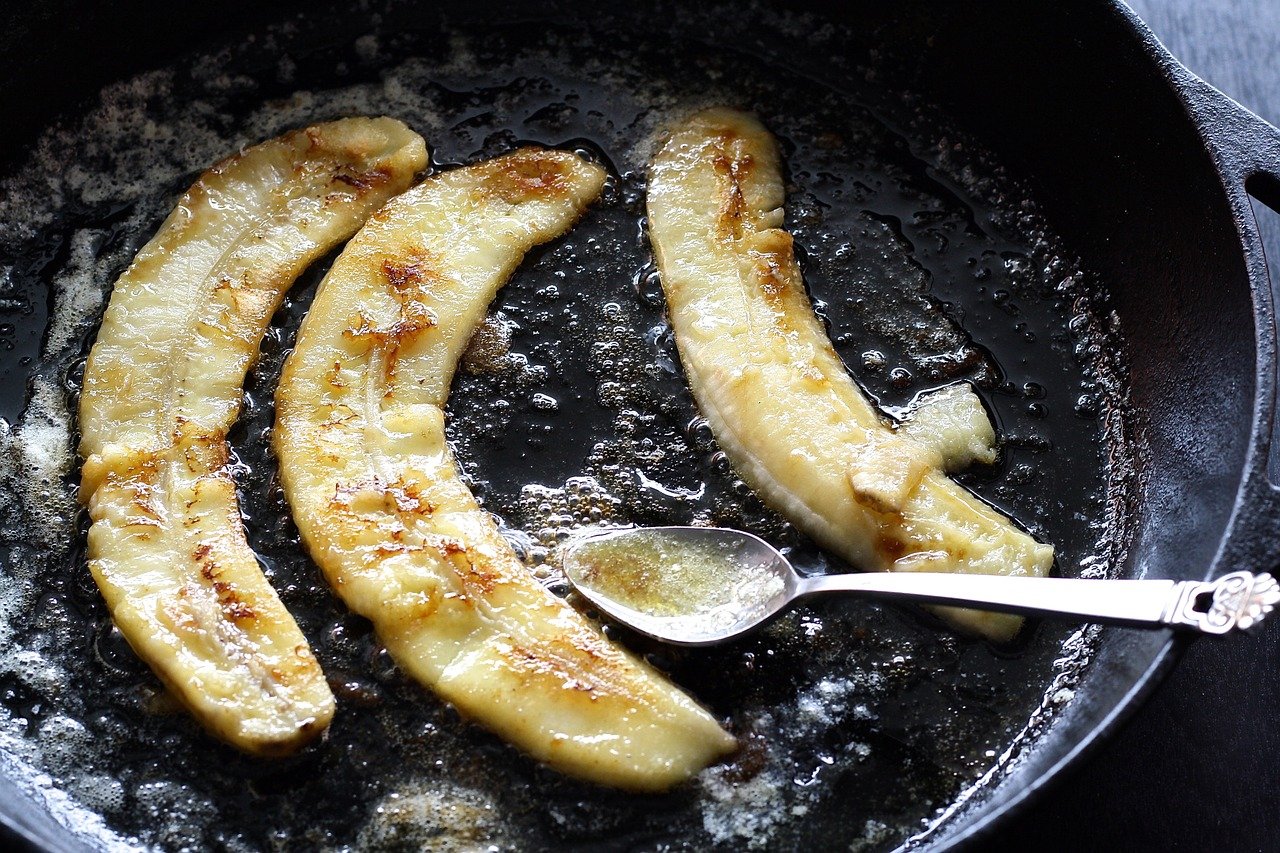
Growing up, I always loved cooking with my grandmother. I inherited several kitchen items from her, and my first (and favorite) task was to learn how to re-season her cast iron skillet.
The re-seasoning process takes time, but it’s completely worth it. Properly conditioned, you can use the skillet for cooking almost everything. While most people use theirs for cooking cornbread or frying, I use it for everything from steak to scrambled eggs. One of my favorite recipes is a blackberry cobbler. There’s just about nothing you CAN’T do. They distribute heat evenly and last seemingly forever.
Why Reseason Cast Iron?
Cast iron cookware is nearly indestructible. It’s versatile, retains heat, is durable, and—with the right seasoning process—is perfectly non-stick. Since it is literally a hunk of metal, the seasoning process is important.
There is advice all over the internet about how best to season a cast iron skillet, and it’s all a little confusing because none of it agrees 100%. Clearly, the same goes for re-seasoning cast iron, which is necessary when a pan has been used a lot or when you’ve bought an old one (like from an antique shop or garage sale). I’ve outlined the stripping and re-seasoning methods I ultimately went with, and I’m happy to say, so far so good.
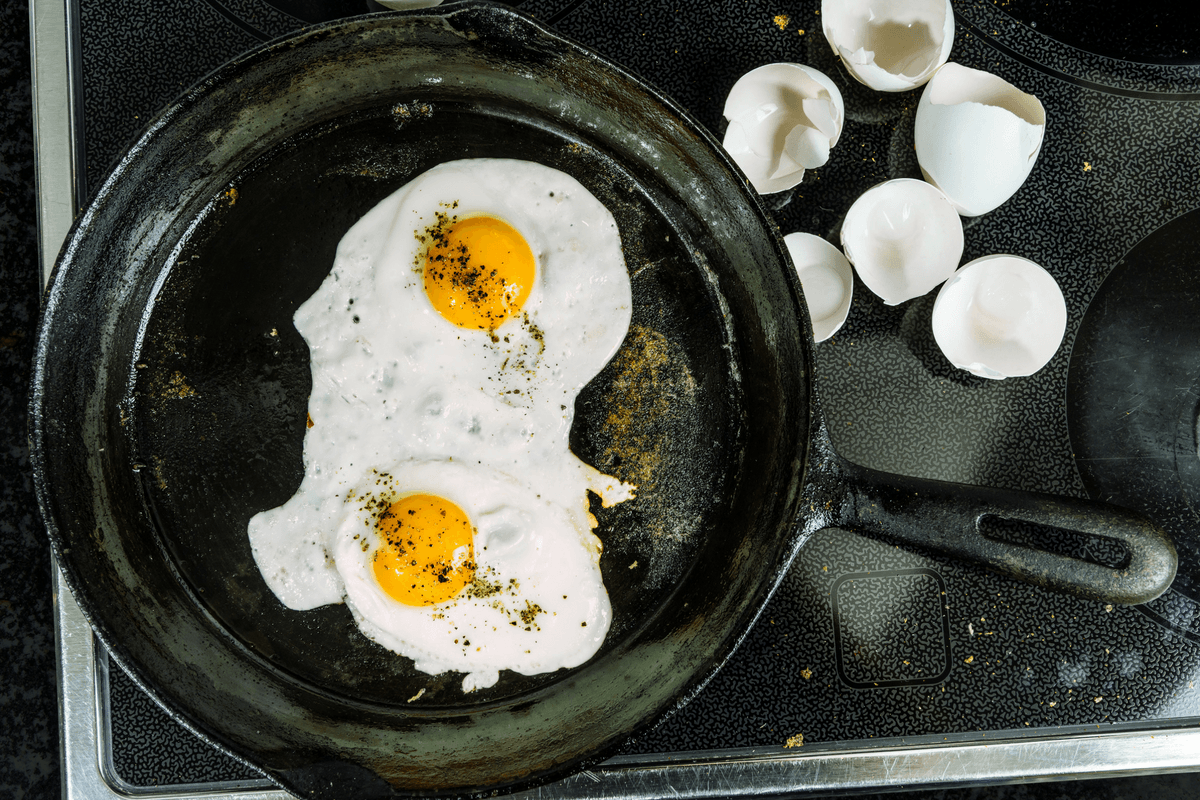
What is Seasoning?
When you buy a new cast iron skillet, it will likely come with some degree of pre-seasoning, but you’ll want to add more layers to make sure it’s in good shape.
What does this all mean? When oil is heated to its smoke point, its fatty acids oxidize into a plastic-like layer of molecules that essentially becomes part of the pan and creates the slick coating known as seasoning. Adding layer after layer makes it even more non-stick and more ideal for cooking.
Reseasoning Process
Since I got my first pan, I’ve totally fallen in love, so I’ve started to collect old pans from garage sales.
Even if a piece has caked-on grime, as long as it sits flat and doesn’t have cracks, it should still work perfectly. There are some amazing deals to be found if you know what you’re looking for. Luckily, it’s easy to restore cast iron cheaply.
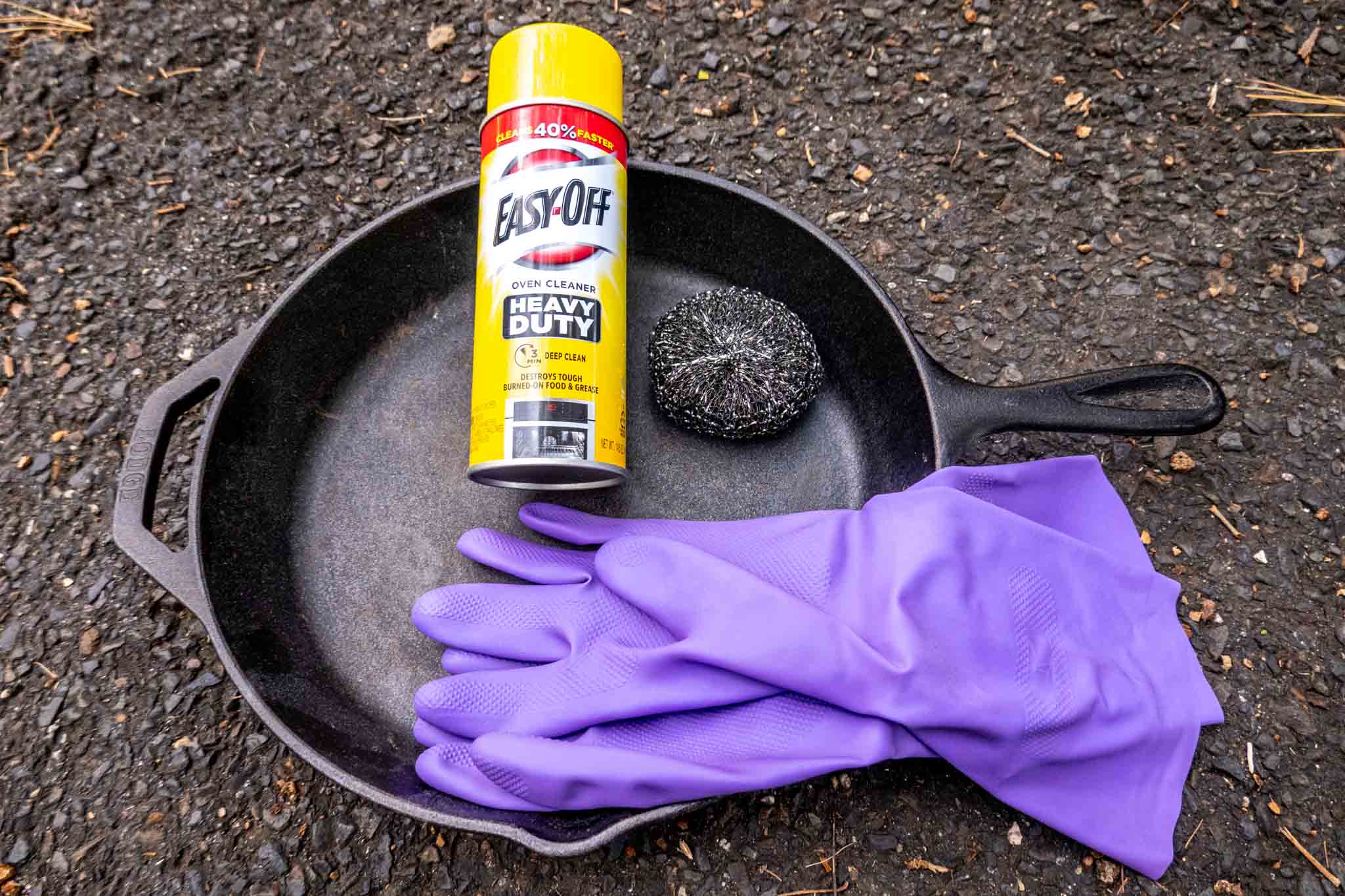
In order to restore the pan, you first need to strip and clean it.
You will need:
Rubber gloves for cleaning
Easy-Off or other heavy-duty oven cleaner (available here)
Trash bags
White vinegar
Note: Lye is a key ingredient in oven cleaner. While it is a caustic agent, the lye residue is washed off the skillet. The pan is then soaked in acidic vinegar and washed before being seasoned. The lye is not absorbed into the metal.
The process:
I strongly recommend doing this outside in order to limit breathing chemical fumes.
1. Put on gloves (this is a must).
2. Cover the cast iron pan completely with Easy-Off.
3. Place it in a trash bag and seal to prevent the oven cleaner from drying.
4. Wait.
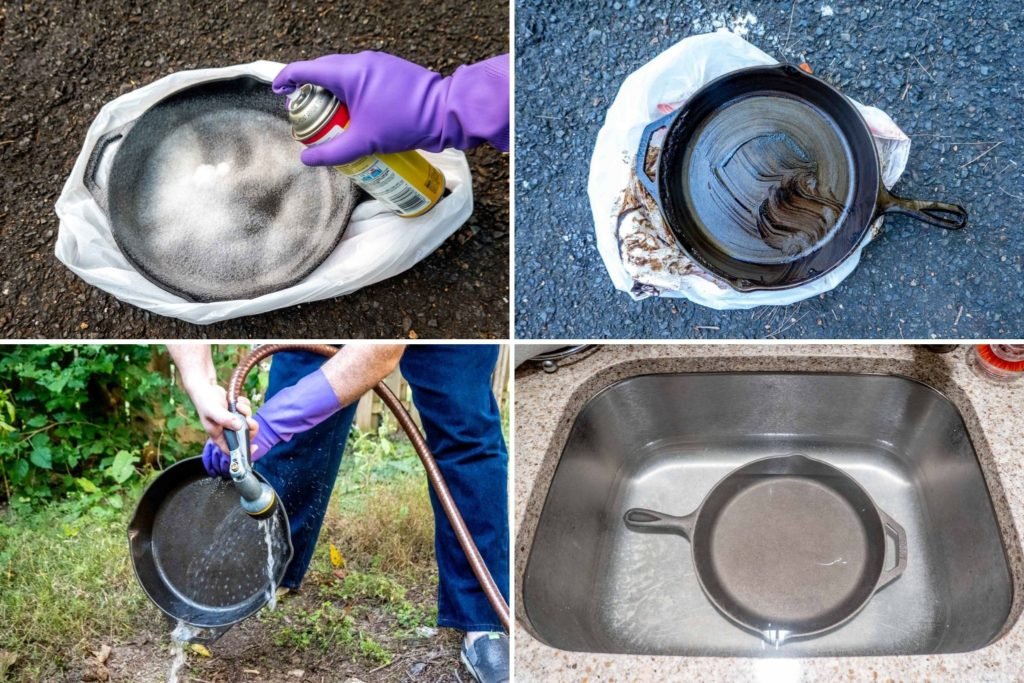
This part of the process often takes several days because the old grime and seasoning can be stubborn. I usually wipe off the cleaner after two days and apply another coat, checking again after 1-2 more days.
5. Remove the Easy-Off with paper towels and wash the skillet. I usually rinse the pan with a garden hose outside before washing it more carefully inside with hot water. Immediately dry thoroughly.
6. Soak the cleaned skillet in a 2:1 solution of hot water and white distilled vinegar up to an hour to neutralize any remaining lye and soften rust. Important: If you see small air bubbles coming off the pan, that is an indication that the solution is “eating” the iron and you should remove the pan immediately.
7. Use steel wool to remove any surface rust.
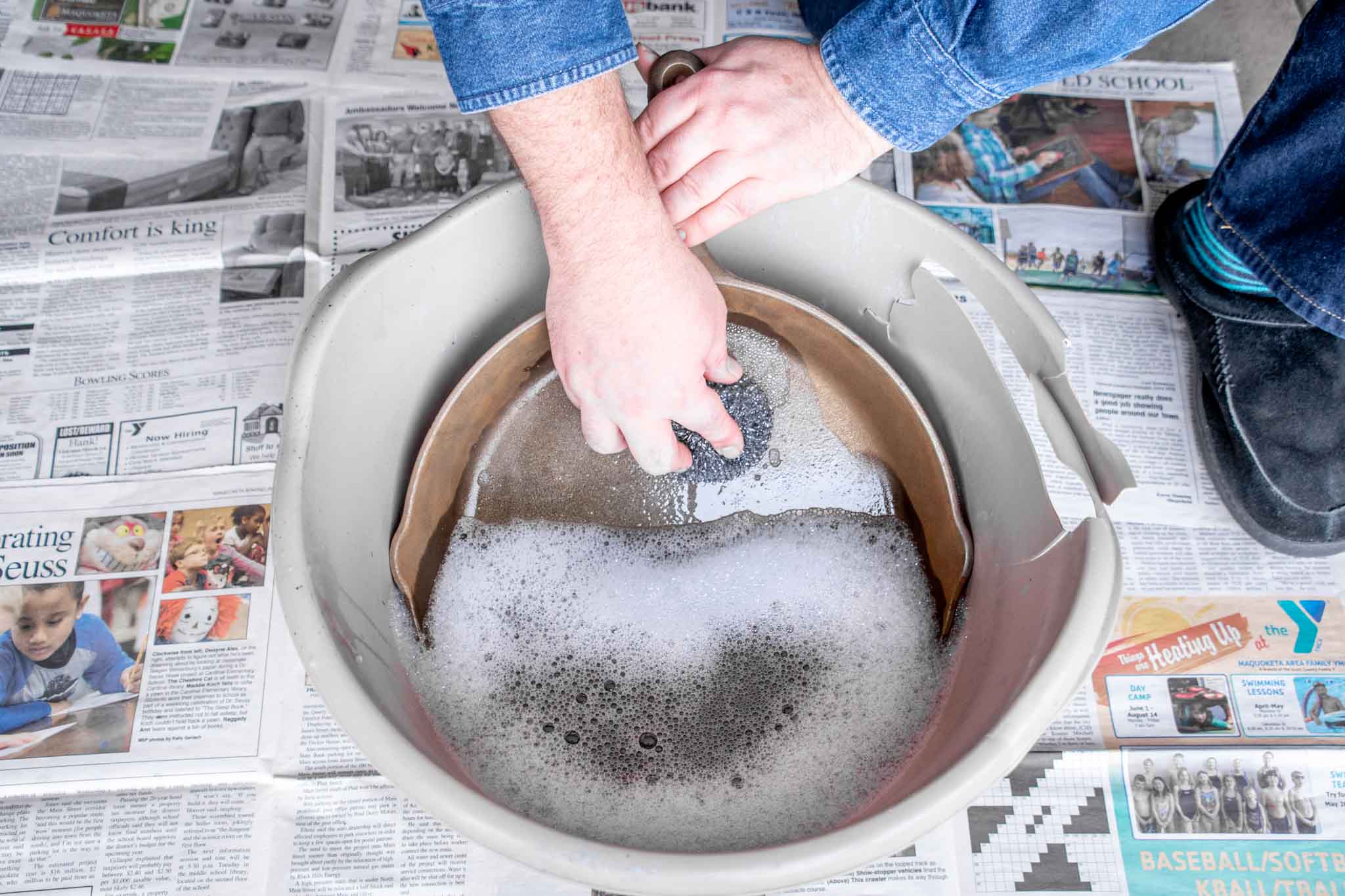
8. Wash the skillet with soap and hot water.
9. Dry thoroughly.
10. Season immediately using the process outlined below.
11. Get cooking!
Self-Cleaning Oven Method
As an alternative to the stripping method described, it is possible to use your oven. Most modern ovens have a self-cleaning feature that can be used to strip and clean cast iron.
To use this method, place the skillet upside-down in the oven and activate the self-cleaning feature for 3-5 hours. This should automatically lock the oven door, but double check to make sure it is locked.
Theoretically, the self-cleaning feature should burn away the grime on the pan. Unfortunately, it has not worked for me and I have still needed to aggressively scrub the pan with steel wool afterward.
How to Season Cast Iron
Even the best cast iron pan will need to be seasoned, and it’s particularly important to do after you strip and clean a pan. This method takes some time, but it is pretty straightforward.
For this part of the process, you will need foil and corn, vegetable, canola, or grapeseed oil. Avoid using extra virgin olive oil, coconut oil, and flaxseed oil because of their low smoke point.
Here are my recommendations for seasoning cast iron cookware:
1. Wash and dry your pan—ALWAYS by hand and never in the dishwasher.
2. To open up the surface, warm the pan for 15 minutes in a 200-degree oven.
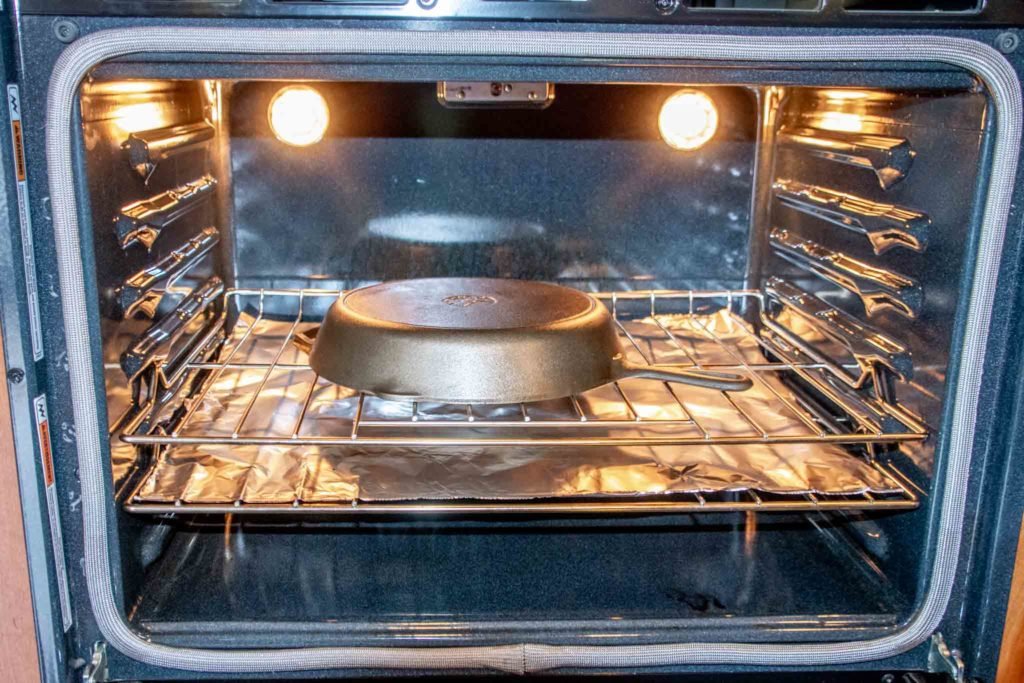
3. Remove the pan from the oven. Rub the oil all over—inside and out, including the handle—using paper towels or a clean rag. (Avoid using anything with lots of lint.) Buff the pan to remove excess oil so it no longer looks shiny.
4. Preheat the oven to 450 degrees.
5. Place the pan upside down on a rack in the heated oven. Place foil on the rack beneath it to catch any drips. Heat the pan for an hour and then let cool.
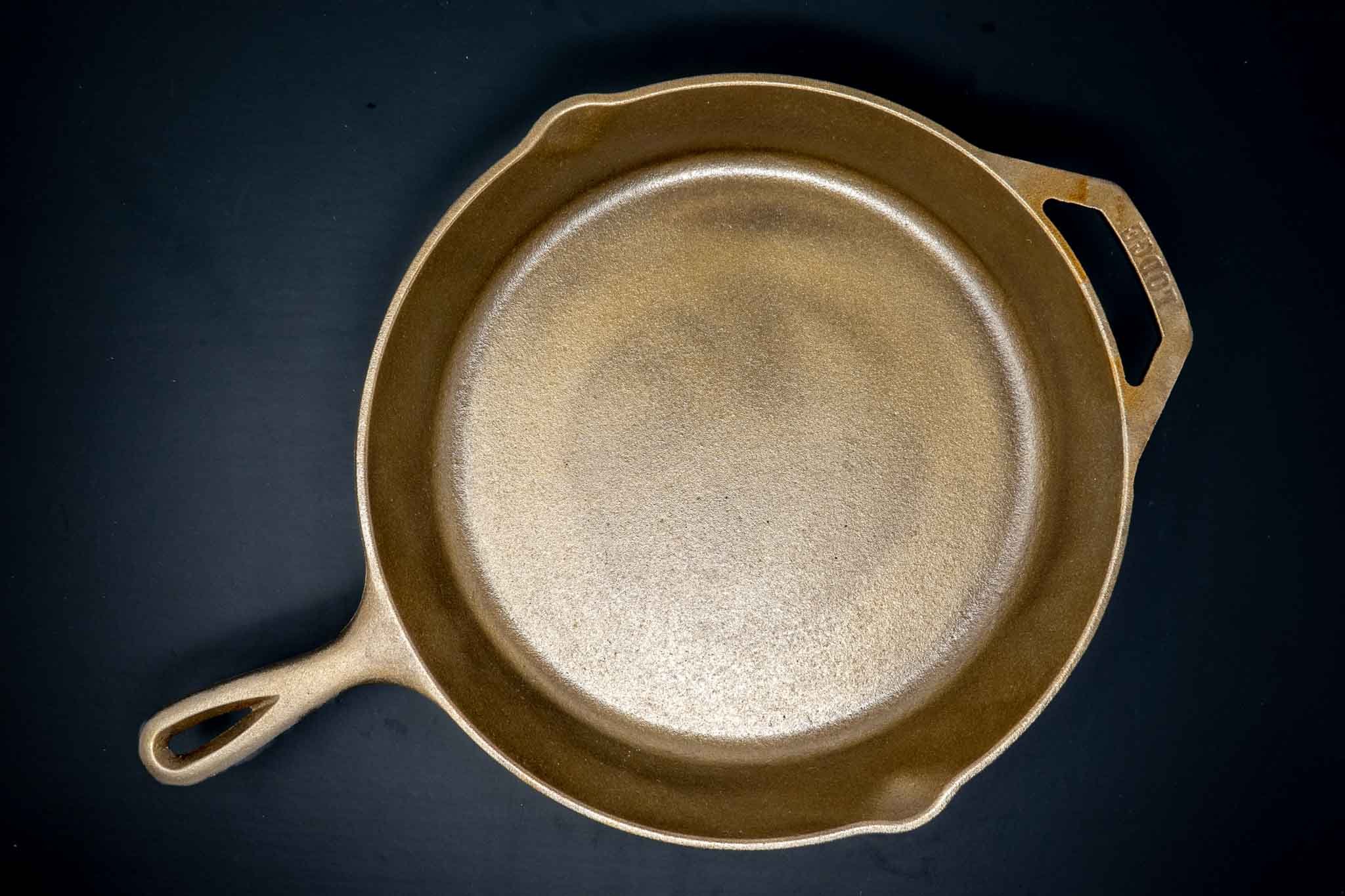
6. Rub the pan with oil as before and repeat the process up to four more times to set your initial layer of seasoning. The pan should develop a gray or amber colored surface that resembles non-stick coating.
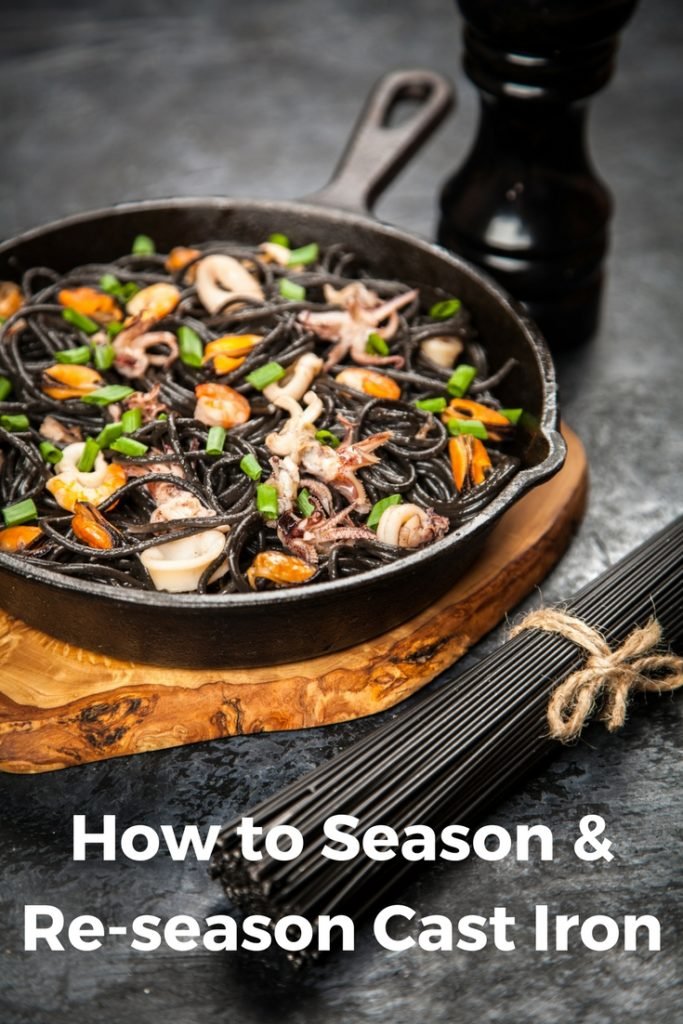
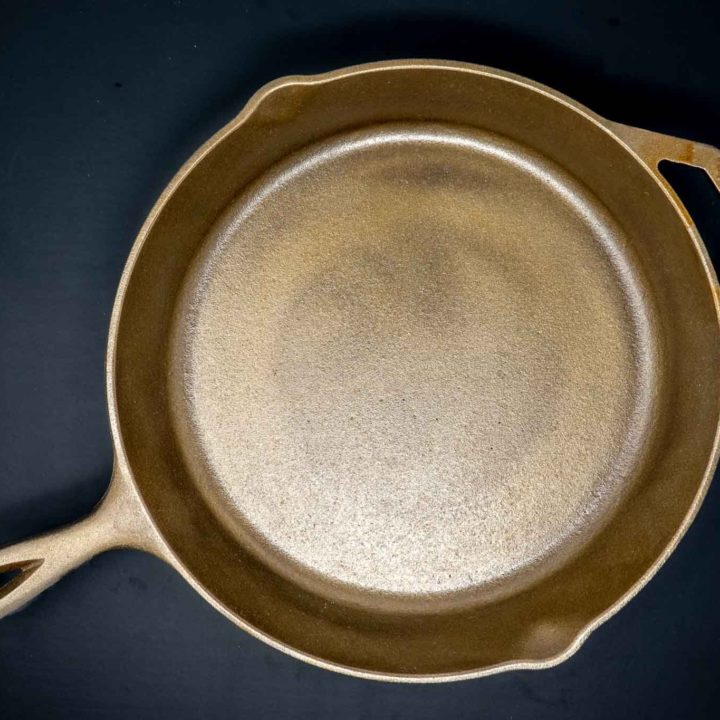
How to Re-Season a Cast Iron Skillet
Bring your cast iron skillet back to life by stripping it and adding perfect new layers of seasoning
Materials
Stripping and Cleaning
- Rubber gloves
- Easy-Off or other oven cleaner
- Trash bags
- Steel wool
- White vinegar
Re-seasoning
- Oil -- corn, vegetable, canola, or grapeseed
- Foil
- Paper towels or lint-free rag
Instructions
Stripping and Cleaning
- Put on rubber gloves.
- Cover the pan completely with Easy-Off.
- Place it in a trash bag and seal the bag to prevent the oven cleaner from drying. Wait two days.
- Wipe off the Easy-Off and apply a second coat. Wait 1-2 days.
- Wipe off the Easy-Off with paper towels. Rinse with hot water. Dry thoroughly.
- Soak the cleaned skillet in a 2:1 solution of hot water and white
distilled vinegar for up to an hour to neutralize any remaining lye and
soften rust. - Use steel wool to remove any surface rust.
- Wash the skillet with soap and hot water. Dry thoroughly.
- Follow the seasoning process.
Re-seasoning
- Preheat oven to 200 degrees.
- Place pan in the oven and warm for 15 minutes.
- Remove pan from oven and increase temperature to 450 degrees.
- Rub oil over all surfaces of the pan, including the handle, using paper towels or a clean rag. Buff the pan to remove excess oil so it no longer looks shiny.
- Place the pan upside down on a rack in the heated oven. Place a sheet of foil on
the rack beneath it to catch any drips. - Heat the pan in the oven for an hour and then let cool.
- Rub the pan with oil as before and repeat the process up to four more
times to set your initial layer of seasoning. The pan should develop a
gray or amber colored surface that resembles non-stick coating.
Notes
1. When removing the Easy-Off residue from the pan, you might want to rinse the pan with a water hose outside before taking it inside to rinse with hot water.
2. While you're soaking the skillet in the vinegar and water solution, if you see small air bubbles coming off the pan, that is an indication that the solution is “eating” the iron and you should remove the pan immediately.
3. When applying oil to the pan, ensure that your paper towels or rag do not have a lot of lint.
IBelieveICanFry.com is a participant in the Amazon Services LLC Associates Program, an affiliate advertising program designed to provide a means for sites to earn advertising fees by advertising and linking to amazon.com, amazon.co.uk, amazon.ca. Amazon and the Amazon logo are trademarks of Amazon.com, Inc. or its affiliates.

I just got my first cast iron skillet , a Lodge. It said it was already seasoned. Do I have to follow this procedure any way?
Strictly speaking, no, but most people find that it’s good to add a layer or two of your own seasoning for good measure. It’s really about personal preference.
Thank you so much for sharing this! I’ve been wondering how I could do this. I just don’t have the heart to throw my skillets out for sentimental reasons. I appreciate it so much!
Yes, i would! Depending on the layering of seasoning!
Hi! Just a quick question: To reseason my own cast iron, do I have to strip it down again as if initially restoring it?? Much mahalos for your time!!
No, you can just follow the seasoning process.
How do you know if a pan needs to be reseasoned? I bought a Griswold at a yard sale recently. Should I just assume it needs to be reseasoned?
I would assume so since you can’t be sure.
Try to cook something in it. If it sticks it needs re-seasoning. When I use my cast iron I wash it, dry it, set it on a cold burner, turn the burner on high until the pan smokes then remove and grease while it’s very hot. NEVER leave on the burner until the pan turns white!! Just until it smokes. You can use spray, solid or liquid oil (usually not olive oil) then you can cook anything you want to just like a non stick pan. I’ve been doing it this way for years and it works well.
I have read your advice and it all makes sense but you don’t address how often you should re-season it. Should I do it after each use? That would be a lot of work. Does washing it with soap and water take off the season enough that I need to do it every use or after several uses? Or just when it starts to stick?
In general, you should not need to re-season it ever. Cast iron skillets should be cleaned with water and a scrub brush only. If you need something stronger, a paste of coarse kosher salt and water can be used. Avoid soap and steel wool at all costs or you will likely need to re-season it.
The inside of my skillet is fine…it’s the outside that has a horrible, thick irregular buildup of gunk…how do I clean that off?
Easy off oven cleaner, it will look like new and cook like new. I was taught growing up to wash the skillet after use and dry it on the stove burner, it has always worked well for me and I re-season it as needed.
I actually placed my Grandmother’s cast iron (my mother had used it too) in my self-cleaning oven and all the old gunk turned grey and I was able to rub it off with a toothbrush. I found that it has “dimples” on the outside that I never knew were there. Then re-seasoned it and am still using it today.
That was about 40 years ago.
What kind of oil is best for seasoning cast iron?
Can you please help me.
I am cleaning the outside of my cast iron skillet with a Dremel and it is taking the black coating off. It is striping it all the way to the silver. Is this okay? Have I ruined my skillet
Thank you for this post.
My daughter put my cast iron pan in the dish washer and I thought it was ruined but I did a full season using the oven cleaner and patience and it’s as good as the day I bought it over 40 years ago.
Thank you!!
After I cleaned it with oven off, I washed the pan., warmed it in oven then coated with oil and baked it. It came out with dimples. It’s not an even finish. Do I keep on with another coat or start again?
An uneven finish is possible if the oil isn’t even. Continue to add layers of seasoning and it will smooth out. You’ll probably need to add several more coats.
I was told to never get the skillet wet. Clean it after use by spreading sea salt over everything and then wiping it out with a paper towel, then a soft cloth.
That’s always been the traditional logic for cast iron. I certainly wouldn’t ever get an older/antique skillet wet. But the more modern cast iron that has been factory seasoned can take a little water cleaning. But you need to immediately dry and reseason. When in doubt, skip the water.